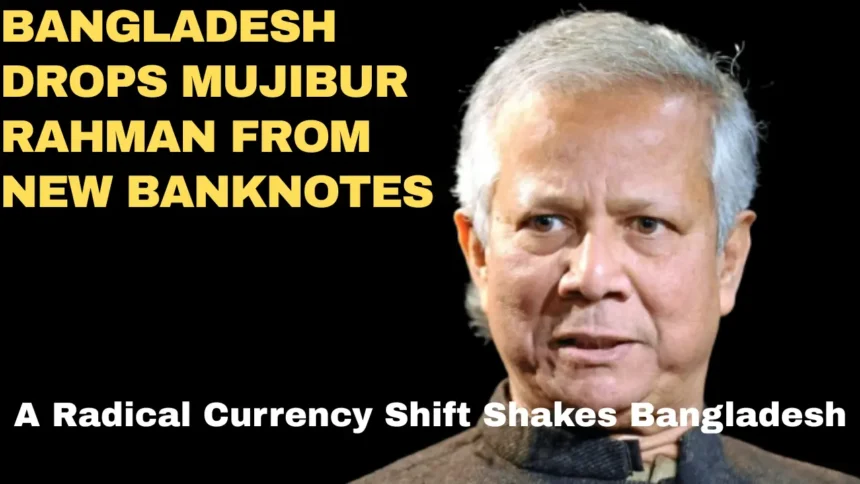Bangladesh Drops Mujibur Rahman from New Banknotes
In a dramatic shift, Bangladesh drops Mujibur Rahman from new banknotes for the first time since the nation’s independence in 1971. The new series, launched by the interim government, replaces the iconic leader’s image with depictions of Hindu and Buddhist temples, traditional artwork, and national landmarks.
This move marks a symbolic departure from decades of political legacy and has sparked both praise and controversy across the country, igniting debates on heritage, inclusivity, and national identity.
A Radical Currency Shift Shakes Bangladesh
In a stunning and historic move, Bangladesh has unveiled new currency notes that no longer feature its founding father, Sheikh Mujibur Rahman. Instead, the fresh banknotes showcase Hindu and Buddhist temples, national landmarks, and famous local artworks, marking a major shift in national symbolism.
This bold change comes amidst political upheaval, mass protests, and the indictment of former Prime Minister Sheikh Hasina — Mujibur Rahman’s daughter — in a violent crackdown case.
Let’s explore what’s really happening and why this change has the whole region talking.
What’s New on the Currency Notes?
Bangladesh Bank launched the revamped notes on Sunday, starting with denominations of Tk 1000, Tk 50, and Tk 20. These new designs are part of a phased currency overhaul announced by the interim government led by Nobel Laureate Muhammad Yunus.
But the most striking detail?
For the first time since 1971, Mujibur Rahman’s portrait is absent from the notes.
Instead, these new notes highlight:
- Images of Hindu and Buddhist temples
- Artworks of renowned painter Zainul Abedin
- The National Martyrs’ Memorial in Savar
The Message Behind the Motifs
According to officials, the redesign is about celebrating Bangladesh’s diverse history and architecture, rather than focusing on any one individual. The notes aim to highlight the multi-religious heritage and cultural richness of the nation — something rarely reflected in state symbols.
Under the new series, no human portraits will be used. Instead, natural landscapes and traditional landmarks will be showcased, said Bangladesh Bank spokesman Arif Hossain Khan.
The move is also aimed at preserving archaeological heritage, promoting tourism, and creating a neutral national identity that includes all ethnic and religious communities.
Where Can You Get the New Notes?
Currently, the revamped currency is available only from the main office of Bangladesh Bank in Dhaka. Over time, the central bank will distribute the notes to other branches across the country.
But don’t worry — existing notes featuring Mujibur Rahman will remain in circulation. The new designs are meant to coexist with the older ones, at least for now.
Political Earthquake: Sheikh Hasina Indicted
The currency change is just one part of a broader political drama unfolding in Bangladesh.
On the same day the new notes were introduced, the International Crimes Tribunal indicted Sheikh Hasina, the country’s recently ousted Prime Minister. She’s facing mass murder charges for her role in a brutal crackdown on student protests.
The tribunal alleges that Hasina exercised “absolute authority” to suppress the protests, leading to numerous deaths. An arrest warrant has also been issued for former Home Minister Asaduzzaman Khan Kamal.
The timing of the indictment and the currency change has led many to wonder:
Is this just a design shift, or a deeper symbolic break from the Awami League legacy?
A Broader Vision or Strategic Erasure?
Critics are divided
Some hail the move as a progressive step toward religious inclusivity and cultural representation.
Others see it as a deliberate sidelining of Mujibur Rahman and the Awami League, suggesting the interim government is trying to rewrite history amid political chaos.
Historian Nusrat Jahan writes:
Removing Mujib from currency is not just about aesthetics. It’s a signal of power. Whoever controls the national symbols, controls the national story.
Why It Matters: A Nation at a Crossroads
This isn’t just about currency. It’s about identity, power, and memory.
Bangladesh is in the midst of a major political and cultural reset. And while the interim government claims neutrality, its actions are sparking passionate responses both at home and abroad.
Religious minorities have welcomed the inclusive imagery.
Awami League loyalists call it “historical vandalism.”
Whatever side you’re on, one thing’s clear:
Bangladesh is rewriting what it means to be Bangladeshi.
Final Thoughts: What’s Next?
With Eid approaching and new notes rolling out, public reaction is expected to intensify. Protests may rise, debates will deepen, and the fight for national identity is far from over.
- Will the next wave of currency include even more religious landmarks?
- Will Mujibur Rahman eventually vanish from all official imagery? &
- How will the global community react to Sheikh Hasina’s indictment?
Stay tuned. Bangladesh is making history — and we’re all watching it unfold.
What’s your take on Bangladesh’s new currency design?
Do you see it as inclusive progress or political erasure?
Drop your thoughts in the comments.
Share this article if you believe history and heritage matter.
For more breaking global stories, follow us at TN HEADLINES24.
Most read: https://tnheadlines24.com/bangladesh-on-the-brink/
Also read: https://tnheadlines24.com/st-martins-island-in-danger-hasinas-bold-claim/
Disclaimer: TN HEADLINES24 assumes no responsibility or liability for the accuracy, completeness, or validity of any information presented in this article. All content is for informational purposes only and reflects interpretations of available public sources.

